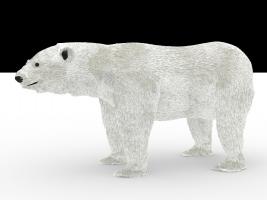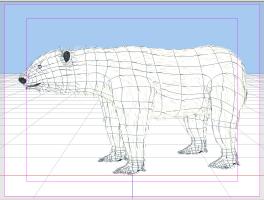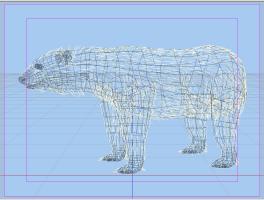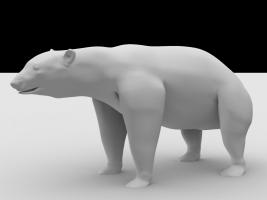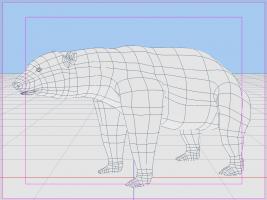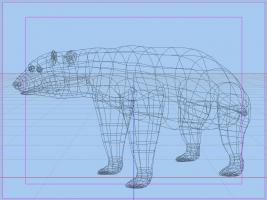-
Posts
5,412 -
Joined
-
Last visited
-
Days Won
89
Content Type
Profiles
Forums
Events
Everything posted by Fuchur
-
That would be Collada or FBX-fileformat at its best. But unfortunally you cant do that with A:Ms exporters right now. (especially FX is very challenging there.) ///////////////////////////////////////////////////////////////////////////////////////////////////////////// DirectX-fileformat has nothing to do with your graphiccard. (and I dont think that there is any graphiccard not using that... nvidia or ATI both give you the option, but on Mac the hardwareacceleartion is based on OpenGL... anyway, the fileformat should be working no matter what. It is just another way to save geometry and animation-data. For rendering purposes, the Soulcage-Department uses another way so: They use OBJ-exports with the MDD-export-plugin to get the geometry and the animation into Modo (which has a nice renderer too). Hopefully some of these informations will help you... See you *Fuchur*
-
Can Max import directX? with that it should not be that troublesome... or Unwrap3d of course... I cant see why someone would like to animate with Max instead of A:M.... modeling maybe if you are more into box-modelling, but animating? That is so much easier and fluid in A:M... (at least when I last checked Max in version 7 it was quite unpleasent...) Anyway: Have a look at my FBX-Pipeline (see signature) too... that one could help you guys too. See you *Fuchur*
-
Are you an experienced game-programmer? In general you need to activate the animations in the gameengine by script. I am not used to Panda3d... If I load the file in fragmotion (for example) I can see the animations, so it does not seem to be anything wrong with them and I can use them in Quest3d. (it may be that the scale is not what Panda3d is expecting maybe). It is not really my code but I am only hosting it since the real developer had to leave it alone, but yes in general you should be good if you got the possibilities to use MVC (not included in Visual Studio Express but only in higher versions). Steffen can tell you more about that so... See you *Fuchur*
-
Cool guy and a good start! See you *Fuchur*
-
Hi Martan, no problem. This is a *.x-file I created with A:M to use it in Quest3d and Unity3d. It is a simple character, with a couple of animations embedded like walk, got_hit, etc. Hope it helps . See you *Fuchur* Hitball_Boy_with_animation.zip
-
- PAL-standard is 25 fps. (in reality is it not defined in the PAL-definition, but for simplicity lets say it is) - NTSC-standard is 29.97 fps. (the uneven number is only happening because of a trick this format is using... in general you can go with 30 fps). - HD-standard today is 50 fps (720p/i or 1080p/i). - Cinemas used to use 24 fps. I am not sure what they do today with digital projection and stuff, but 24fps should be okay for that.) In general I would say you can go with 25 fps. That will be okay for most stuff. 25 will although be okay for youtube and stuff... some people think that even 15 fps are okay for web-videos, but I dont think so... 25 is the lowest you should use. See you *Fuchur*
-
Hello all! As some of you may already know from this thread, Jason added a new item to the store (thank you very much Jason ) with which it is now possible to add additional rendernodes to your A:M licence. Many have asked for it and I didn't want this info to be buried in a thread with another topic title... Here you can find additional informations: - Activation page with Step-by-Step-Instruction - Hash store - Add rendernodes - FAQ: How to install my new master0.lic file after I bought more Render Nodes (Win) - FAQ: How to install my new master0.lic file after I bought more Render Nodes (Mac) (available soon, but the process already works for Macs too) Some of you may not know what a rendernode is: A rendernode can be used in combination with A:M Netrenderer and allows you to render with more cores (if available) at the same time. So if you for example have 3 computers and each one has 4 cores, you can render 12 frames at the same time with A:M Netrenderer (available in v16 for free) in (about) the same time as it would take to render one frame. Shortly spoken: This enables you to do your own little renderfarm with A:M Netrenderer. In the store you can now get 4, 10, 25 and 50 rendernodes as a product. And if that is not enough for you: You can of course buy more than just one item for your licence... like that you can for example buy 75 (25 + 50) or 100 (50 + 50) rendernodes, add them to your licence and render with it. (I doubt, that anyone has that many cores standing around, but who knows?) Best wishes and have fun! *Fuchur*
-
Best wishes David! See you *Fuchur*
-
Thanks for the tip, Robert. So I save my current copy of master0.lic and then copy it into the V16.0 folder (both 32 & 64 bit) after the installs? Does this also apply for someone such as myself who paid the premium for a "permanent" copy? And speaking of saving files; I know *.sch files are the color schemes but where are the custom keyboard shortcuts saved? And while we're talking about fresh installs, during the first installs there are check boxes pre-selected with "Register Extensions" and "Don't install additional plug-ins". Since they were checked by default I went with them but I'm curious; what in blazes do they mean and why are they optional? > Should be the same for permanent and subscription-owners, yes. > Keyboardshortcuts are saved in the file "Master_64.MAC" / "Master.MAC" if I am not wrong... (I may be wrong so... just a dark memory from somewhere deep inside my head ). > Registe Extenstions is an options which asks you if you want to open files with the extension "*.mdl"... (and so on) with A:M by default. > Don't install additional plugin-ins" asks, if it should install a few more plugins of Steffen. It has been introduced because of some sort of error Steffen hat while programming v17 just in case it would be needed. I am not sure if it is still activly doing anything or needed so... See you *Fuchur*
-
Robcat... um.. no. Wish there was a pop up message at installation that said copy this license file to your external backup. Will remember this, though. Go to the image of your old drive that I recommended you make several posts ago... ...and you will find your master0.lic file in the folder where A:M was installed. Or go to your old hard drive that the SSD replaced. What? You reformatted your old hard drive? I'm pretty sure no one recommended that. Not that important. Do you still have your activition-code? That should be enough to identify you (if I am not totally wrong) and will give Jason the possibility to reassign your licence. (don't post it here!) Anyway in future: Be more careful with your lic-file. It is recommended to have it backuped somewhere. See you *Fuchur*
-
It is not an automatic procedure so it may need a little till Jason can help you. This evening Jason will do some serverwork but I am sure he will talk to you soon. See you *Fuchur*
-
I loved this video! Made me smile! AND fortunately at around 5 secs there was a small side view of a polar bear shape - so here is a rough outline of that polar bear with your model (not exactly side view). Maybe this helps get closer to the shape? Hi Nancy... thank you very much The outlined version you provided brought me much closer to the shape! That is a good trick to simplify the image before trying to do the modelling. It helps to focus on what you want to create and not getting distracted by any details you don't need to focus on in the earlier stages . I cutted the renderingtime to 1/3 till now by just lowering the density and readjusting a few settings... next I will try an hair-image which will represent several hairs, so that I can multiple it without a much bigger rendertimehit. Maybe I can lower it again with that. Thank you all for your very helpful responses . See you *Fuchur*
-
I don't think there's an alpha channel for sound. Or is there? Sound card claims may have even more marketing wizardry at work than graphics card claims. I see Audacity offers 16-bit integer, 24-bit integer and 32-bit Float as options. Agreed... sound card claims are crazy. Though in sound software, I gotta give it to Sound Forge Pro for having the coolest spectrograms ever. -- Upgraded to an SSD. Reformatted my drive first to see what happened. Animation Master didn't work. No surprise. Sent a support email with pdf of my receipt to support at hash dot com or whatever the email was that comes up when you type in the code for validation. No response. The quickest rental period I've ever had... lol. No seriously, this has got to be fixed. If copying the master0.lic-file has happend and it does not work, please follow the steps here to provide the informations Hash will need to reassign your licence. It may take a day or two (especially if we are talking about weekends inbetween) before they will answer you. See you *Fuchur*
-
The following image was used to model him, but it is a menacing gesture he is doing there (and he is not a real polar bear but a sculpture in a museum). Anyway I will have to look at the hair and how I can cut some of it away... the attached image was rendered with hair and took about 10h... that is a little much for my taste for one image. I did readjust his back-height a little and think it is better now, but I did not yet change his neck-length in the rendered image. But I think you are right... I will have a look at the length of his neck again. It is just a tiny little bit out of shape. I think the fur made his head a little too big in comparision to the body too. And here is something heartwarming you may not have known. They can be really nice guys: See you *Fuchur*
-
I am more into creating things by myself. That is just more fun and gives me a better feeling when working with it. Anyway thanks... I will check it out if I can find it. See you *Fuchur*
-
I like polar bears very much and like that I started to model a male one two days ago. (these guys can be up to 3.60m from head to bottom... don't wanna fight with one ) Today I am close to start texturing (he still needs claws and teeth) but before I do that, I wanted to know if someone has advises for him so I dont have to re-texture him later on. Let me know what you think . See you *Fuchur*
-
So as everybody seems to be reintroducing him/herself I will take my turn here too. My first contact with A:M was around 1998 when there was a brochure with different software in it when my first 3d software (called Monzoom 3d / Pro by Oberland) I used was discontinued. One of the software packages in there was Animation:Master. Later the company of the 3d software I used before offered a sidegrade to C4d for quite good conditions, but I had seen A:M with the cool superhero-character (don't know his name... radioactive man? ) and wanted to try it. So if this superhero wouild not have been created, I would not be here and if Hash or a reseller had not decided to advertise in the brochure, I would never ever have heard of A:M and would very likely be a C4d guy or not into 3d anymore at all. Anyway in 2000 I decided to get version 8.0 of Animation:Master and began to learn. I loved it and got my update for v10 later on. Since then I updated to any version that came out. (v10-16 / v17). I never used v8.5 or 9.0 (and from what I heard, I am not missing v9 ). Today I work at an mid-size advertising agency in Germany called 3We, creating educational and advertising(often for big tradeshows, etc.) 3d-animations often in the medical area (eye surgery, contact-lenses, etc. and animal medicine) but although in the technical part. Customers are for example Pfizer, Bosch, SEW Eurodrive, Abbott and Zeiss Dental Services. Aditional to my 3d-work (which is a smaller part of what I do at 3We) I am head of the web development team at 3We and part of the video-editing and post-production team. I do all that mostly with A:M but although use XSI and 3ds for CAD-input. If A:M would have good importers for CAD-data or could handle those better, I would not use the other programms, since I find them much less intuitive and thought through. Maybe the new Resurface-Tools makes it easier for me there... Like that the only 3d-software I use in my sparetime is A:M. On the forums I try to be around as often as I can (usually several times a day), and I try to help the users and Hash where I can. (an example: The website you are currently visiting (not the forum but the website) is a developement of Jason and me and you can find many video-tutorials about A:M on my website...). I am sure we will meet sooner or later on the forum again . See you *Fuchur*
-

Threw this together for fun...
Fuchur replied to MMZ_TimeLord's topic in Work In Progress / Sweatbox
Never ever heard about it... have to have a look at it. See you *Fuchur* -
Yes, but keep in mind you still have only linear morphing there... it will not look the same as real bone-animation. Anyway it would be possible for a elbow or something. You could get away with 3-5 keyframes there... for more komplex animation it would not work... anyway it could be a very nice addition... See you *Fuchur*
-
As far as I understand it: You import the MDD-data into an Action. After that you've got keyframes (in A:M) in the action. In the action you can now copy the CP-animation-data in muscle-mode, create a new pose for your character, go to the percentage the keyframes you copied from the action should be at and just paste it. However you will not very likely get around rigging again, at least not for more complex motion. CP-animation is linear and will "morph" from A to B. If you need to move an arm or so you need bone-animation with joints which will create the arcs automatically... for basic morphing like it often happens in the face you can get it done with that method (very well) but for example a walking character will look very strange if you don't copy and paste each frame a keyframe. See you *Fuchur*
-

Threw this together for fun...
Fuchur replied to MMZ_TimeLord's topic in Work In Progress / Sweatbox
Don't think so... Somehow I have an assosiation with a roboter head with an eye in the middle like the one from Planet51 (Rover) or something like that... So I am not totally sure. *Fuchur* -
A:M only uses one core for renderings in A:M itself. You can only use more than one by opening A:M several times or by using Netrenderer with several netmessengers. In any case each core will only work on one frame at a time. > a frame is only as fast rendered as one core would do, but you can (in your case) render 12 of them at the same time. (if you have the licence to allow that... there should be an option to add rendernodes to your licence very soon, if Jason finds the time to test the new php-formular on the website. my first developement-tests were successful) See you *Fuchur*
-

0006058: Customized Support Tab in A:M Community
Fuchur replied to Rodney's topic in Animation:Master
That is a good idea . I am with you on that and integrated it into my page. (no action necessary on your side) For now I added the link to this discussion and if A:M v17 is officially release we will have to change that to the openly available forum-board for that. (I would add a own board where people can share what they created on the forums here) There is now a button to change the images if you want to. See you *Fuchur* -

0006058: Customized Support Tab in A:M Community
Fuchur replied to Rodney's topic in Animation:Master
The only reason there is the *.htm or the *.html-extension is the 8+3-notation / Camal-notation available but it would be bad practice to use them in a different way. One of the reasons would be that Windows does not show the extension by default for users but the icon would be the same. Like that you could not see the difference on a windows-filesystem without changing that. The other one is, that what is prefered is a webserversetting. Many webservers will favour the index.html over the index.htm-file and only use index.htm only if index.html is not available. After that it will be checked if there is a index.php but this is really only a setting which can be changed and is very different on different machines. The best is, to just let the webserver determine which file should be shown. So don't use "http://xyz.com/index.htm" as the link but "http://xyz.com". The webserver will guide you where you need to go. I for myself prefer the *.htm over *.html because I just like to stay compatible to as many systems as possible. I think the x+y-notation (in difference to x+3) is only a game or only really useful when there are so many file-extensions are involved that 3-letters are just not longer enough. Anyway: The most compatible format is x+3 or even 8+3 and like that I reccomend to use that. See you *Fuchur* -
You can disable that behaviour in future BUT it can lead to problems... so you don't really should do that. In the end the Basic colors are still better than XP-styles... it wont change anything in A:M in any way but only the taskbar would look a little different. OpenCL is currently looked into... it seems, as if it is not very easy to optimize A:M rendering with it (just doesn't really help much, since Patch-rendering is different from polygon-rendering). But we will see what the future brings. See you *Fuchur*










